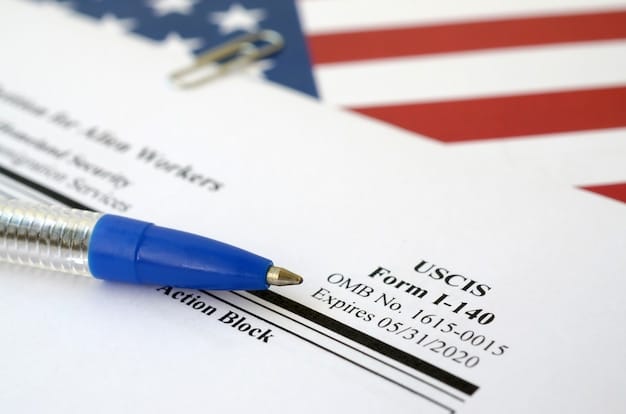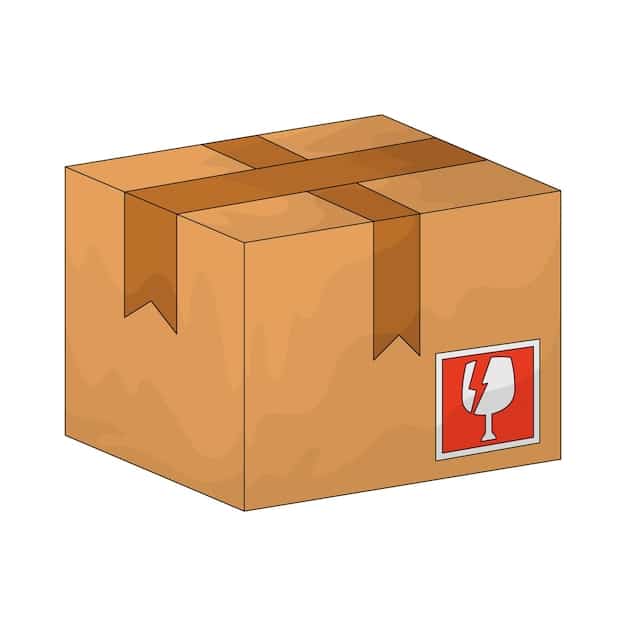Shipping Souvenirs Home: A US Shopper’s Guide to Japanese Postal Services and Customs

Navigating the complexities of shipping souvenirs from Japan to the US involves understanding Japanese postal services, customs regulations, and potential costs, all crucial for a seamless and compliant import process.
Bringing home unique Japanese souvenirs is a highlight for many US travelers, but the challenge often begins when luggage space runs out. This guide, focused on Shipping Souvenirs Home: A US Shopper’s Guide to Japanese Postal Services and Customs, provides essential insights into making sure your cherished items arrive safely and compliantly, directly to your doorstep.
Choosing the Right Japanese Postal Service: Options and Considerations
When it comes to shipping your precious finds from Japan, the Japan Post (Japan Post Co., Ltd.) is your primary and most reliable partner. They offer a range of services designed to meet different needs in terms of speed, cost, and tracking capabilities. Understanding these options is the first crucial step to ensure your souvenirs arrive safely and efficiently.
Express Mail Service (EMS)
EMS is often the preferred choice for many travelers due to its speed and comprehensive features. It’s the fastest international mail service offered by Japan Post, typically delivering packages to the US within 2-5 business days. This service includes tracking and insurance, providing peace of mind, especially for valuable or fragile items. While it’s the most expensive option, the blend of speed, reliability, and security often makes it worthwhile for important shipments. For instance, if you’ve purchased a delicate antique kimono or a limited-edition anime figure, EMS would be highly recommended. The tracking system is robust, allowing you to monitor your package’s journey from Japan to your US doorstep in real-time.
- Speed: Fastest available (2-5 business days).
- Tracking: Comprehensive end-to-end tracking.
- Insurance: Included for loss or damage up to a certain value.
- Cost: Generally the highest due to premium service.
Airmail (Small Packet or Parcel Post)
Airmail, categorised into Small Packet (for packages up to 2 kg) and Parcel Post (for heavier items), offers a balance between cost and delivery time. Small Packet is an economical option for lighter items, often taking 1-2 weeks to reach the US. Parcel Post, while slightly slower than EMS (usually 5-10 business days), is still a relatively quick option compared to surface mail and is more affordable than EMS for larger, heavier packages. Both Airmail services typically include basic tracking, but the level of detail might vary, and insurance is often an add-on. This makes it a good choice for items that are not urgent or extremely valuable, such as clothing, books, or smaller household goods.
- Small Packet: Ideal for lightweight items (under 2 kg), budget-friendly, 1-2 weeks delivery.
- Parcel Post: Suitable for heavier items, more affordable than EMS, 5-10 business days delivery.
- Tracking/Insurance: Basic tracking often included, insurance usually optional.
SAL (Surface Air Lifted)
SAL is a hybrid service that leverages surface transport within Japan and the US, combined with air transport for the international leg. This makes it significantly cheaper than EMS or Airmail, but also considerably slower, with delivery times ranging from 2-4 weeks or even longer, depending on the destination and current global shipping conditions. Tracking and insurance availability for SAL can vary, and it’s generally not recommended for time-sensitive or highly valuable items. It’s best suited for non-urgent, non-fragile, and bulkier items where cost is the primary concern, such as a collection of Japanese snacks, stationery, or less delicate souvenirs. Some post offices might not even offer SAL for specific destinations due to logistical complexities.
Surface Mail (Sea Mail)
Surface mail, or sea mail, is the slowest but most economical option. Packages transported via surface mail can take anywhere from 1-3 months, or even longer, to arrive in the US. This service typically offers minimal to no tracking and very limited insurance options. It’s generally chosen only for very heavy, non-urgent, and non-perishable items where cost savings outweigh the long transit time and lack of tracking. Think of items like traditional Japanese futons, large ceramic planters, or a substantial collection of print media. Before opting for surface mail, consider the seasonal fluctuations in shipping traffic, which can further extend delivery times.
Understanding these services provided by Japan Post is fundamental. Each option presents a unique balance of speed, cost, and reliability. Choosing the right one depends largely on the nature of your souvenirs, their urgency, and your budget constraints. Carefully evaluate your needs before making a decision, and always verify current shipping rates and restrictions directly with Japan Post, as these can change.
Packing Your Treasures: Tips for Safe Shipping from Japan
Proper packing is paramount when shipping souvenirs internationally, especially from Japan to the US. The journey can be long and involve multiple transit points, so ensuring your items are well-protected is crucial. Think of your package as an investment that needs robust safeguarding to reach its destination intact.
Selecting the Right Packaging Materials
The foundation of good packing lies in choosing appropriate materials. Use a sturdy double-walled corrugated cardboard box that is strong enough to withstand potential impacts and stacking. Avoid using flimsy boxes or those that show signs of damage. For fragile items, invest in bubble wrap, foam peanuts, air pillows, or crumpled paper to provide ample cushioning. Filling all empty spaces within the box is critical to prevent items from shifting during transit. If you’re shipping liquids, ensure they are in leak-proof containers and sealed in plastic bags to prevent damage to other contents if a spill occurs. Similarly, sharp objects should be properly sheathed and protected.
- Box Quality: Use new, sturdy double-walled corrugated cardboard boxes.
- Cushioning: Employ generous amounts of bubble wrap, foam, or crumpled paper.
- Empty Spaces: Fill all voids to prevent movement and potential damage.
Protecting Fragile Items
Fragile items, such as ceramics, glass, or delicate electronics, require extra attention. Each fragile item should be individually wrapped and then cushioned within the box. Consider the “box-in-a-box” method for extremely delicate items: place the item, wrapped and cushioned, into a smaller box, then cushion that smaller box within the larger shipping box. Clearly label packages containing fragile items with “FRAGILE” stickers on multiple sides. While this doesn’t guarantee careful handling, it serves as a visual alert to handlers. For extremely valuable or fragile items, professional packing services (often available at larger post office branches or private shipping centers) might be a worthwhile investment.
Addressing and Labeling Your Package
Accurate and clear labeling is critical. Ensure the recipient’s full name, complete US address (including ZIP code), and a contact phone number are clearly written on the package. Your return address in Japan (or a temporary forwarding address if you are still traveling) should also be prominently displayed. Use indelible ink and consider using address labels that adhere strongly to the box. Placing a duplicate address label inside the package is a good practice in case the outer label becomes damaged or detached. For international shipments, customs declarations forms will also need to be filled out accurately and visibly attached. Double-check all information before handing over your package to avoid delays or misdelivery.
The effort you put into packing will directly influence the condition in which your souvenirs arrive. Skimping on quality materials or proper techniques can result in damaged goods, leading to disappointment and potential claims processes. Take the time to pack thoughtfully and securely, as it’s an investment in the safety of your cherished memories.
Navigating US Customs Regulations: What You Need to Know
Understanding US Customs regulations is just as critical as choosing the right shipping method from Japan. Failing to comply with these rules can result in delays, fines, or even seizure of your items. The goal is a smooth, hassle-free entry for your souvenirs into the United States.

Customs Declaration Forms (CN22/CN23)
When shipping internationally, you will be required to complete a customs declaration form, typically a CN22 for small items or a CN23 for larger parcels. This form requires you to accurately describe the contents of your package, state their value, and declare whether they are gifts or merchandise. Honesty and precision are key here. Misrepresenting the contents or value can lead to penalties. For instance, declaring a high-value item as a low-value gift to avoid duties is illegal and can have severe repercussions. Be as specific as possible: instead of “gifts,” write “Ceramic Tea Set” or “Cotton Kimono.” The customs form also asks for the country of origin, which for your souvenirs will typically be Japan.
- Accuracy: Fill out forms precisely with true descriptions and values.
- Specificity: Avoid vague terms like “gifts”; be descriptive of individual items.
- Declaration: Distinguish between gifts, personal effects, or commercial goods.
Import Duties and Taxes
When sending items to the US, the recipient (in this case, you as the shopper) is generally responsible for any import duties or taxes levied by US Customs and Border Protection (CBP). The de minimis value for personal imports into the US is currently $800. This means that if the total declared value of your shipment is $800 or less, it’s generally exempt from duties and taxes. However, items above this threshold may be subject to duties, which vary based on the item’s classification, country of origin, and the trade agreements in place. It’s advisable to check the current CBP guidelines or use an online duty calculator if you anticipate your shipment’s value will exceed the de minimis threshold. Certain items, even below the threshold, might still incur specific fees or require special documentation.
Prohibited and Restricted Items
A critical aspect of customs compliance is knowing what cannot be imported into the US or what requires special permits. Common prohibited items include certain agricultural products (fruits, vegetables, seeds, plants), specific animal products (bushmeat, certain types of ivory), controlled substances, and counterfeit goods. Restricted items might require permits (e.g., firearms, certain medications, specific cultural artifacts). For instance, if you buy a traditional Japanese sword, it might be classified as an antique or a weapon, each with different import rules. Similarly, food items like fresh produce are generally prohibited, but commercially packaged snacks might be allowed with proper labeling. Always check the CBP website for the most up-to-date list of prohibited and restricted items before shipping anything. Ignorance of these rules is not an excuse and can lead to immediate seizure and destruction of goods without compensation.
Navigating US customs can feel daunting, but by being diligent with your declarations, aware of potential duties, and informed about prohibited items, you can ensure your Japanese souvenirs arrive without issues. Planning ahead and being transparent on all documentation will save you time, money, and potential headaches.
Estimating Shipping Costs: Budgeting for Your Souvenirs
Shipping costs can significantly impact the overall expense of your Japanese souvenirs. Beyond the purchase price, understanding and estimating these costs is crucial for effective budgeting and avoiding unpleasant surprises upon arrival. Several factors contribute to the final shipping fee.
Factors Influencing Shipping Costs
The primary factors determining shipping costs are the weight and dimensions of your package. Heavier and larger packages will naturally cost more to send. The chosen shipping method (EMS, Airmail, SAL, Surface Mail) is another major determinant, with faster services being more expensive. Destination also plays a role, though for US shoppers, the destination country is fixed. Additional services like enhanced insurance, special handling for fragile items, or delivery confirmation will also add to the total. Japan Post, like most postal services, uses a tiered pricing system where the cost increases incrementally based on weight brackets. Therefore, even a slightly heavier package can jump to the next price tier, disproportionately increasing the cost.
Using Online Calculators and Weight Limits
Japan Post provides online shipping cost calculators on its official website, which are invaluable tools for estimating expenses. Before packing, try to get an approximate weight of your items. Weigh them on a household scale or estimate based on product specifications. Then, input these details into the calculator along with your desired shipping method. Pay close attention to the maximum weight limits for each service (e.g., Small Packet has a 2 kg limit). Exceeding these limits for a specific service means you’ll have to switch to a more expensive option or split your shipment into multiple packages, potentially incurring higher overall costs. Many stores in Japan that cater to tourists might also have scales available for customers to check approximate weights.
Considering Insurance and Tracking
While adding to the cost, insurance and tracking services offer vital protection and peace of mind. For valuable or irreplaceable items, opting for full insurance is highly recommended. The cost of insurance is typically a small percentage of the declared value. Basic tracking is often included with EMS and some Airmail services, allowing you to monitor your package’s progress. For cheaper services like SAL or Surface Mail, tracking might be an optional extra, if available at all. Weigh the cost of these services against the potential loss or damage of your items. For instance, a $20 extra for insurance on a $500 item is a small price to pay for security. Without tracking, if a package is delayed or lost, locating it becomes significantly harder.
Budgeting for shipping involves more than just looking at base rates. It requires considering the full scope of your items, the desired speed of delivery, and the level of security you need. Factor in these costs early in your shopping process to avoid any financial surprises later on. A little bit of research and planning here can save you a lot of money and stress.
Common Souvenirs and Their Shipping Specifics
When considering shipping souvenirs from Japan to the US, the type of item often dictates the best approach, especially concerning packing, customs, and potential restrictions. While many items are straightforward, some unique Japanese products warrant special attention.
Textiles and Clothing (Kimono, Yukata, etc.)
Textiles like silk kimonos, cotton yukata, and traditional fabrics are generally easy to ship. They are relatively lightweight and not fragile. Ensure they are clean and dry before packing to prevent mold or mildew during transit, especially if using a slower shipping method like SAL or Surface Mail. Fold them neatly to minimize wrinkles. From a customs perspective, most clothing items are straightforward. Declare them accurately (e.g., “Cotton Yukata,” “Silk Kimono”) and state their value. Generally, textiles don’t face specific import restrictions unless they are made from endangered animal hides or contain certain dyes (which is rare for typical souvenirs).
Ceramics and Glassware (Tea Sets, Sake Cups)
Japanese ceramics and glassware, such as exquisite tea sets, sake cups, or decorative pottery, require meticulous packing due to their fragility. Each piece should be individually wrapped in multiple layers of bubble wrap, then cushioned in a sturdy box with ample void fill. Consider double-boxing for added protection. Label the package clearly as “FRAGILE.” Customs typically considers these as general merchandise. Ensure the declared value is accurate, especially if they are valuable artisan pieces. While not usually restricted, items made with certain glazes containing lead might face scrutiny, though this is uncommon for modern, commercially produced souvenirs.
Food and Snacks (Packaged Sweets, Instant Noodles)
Shipping food items can be tricky due to strict agricultural and food safety regulations in the US. Commercially packaged, shelf-stable snacks, candies, and instant noodles are generally permissible, provided they are in their original, unopened packaging with clear ingredient lists. Avoid shipping fresh produce, meat products, or homemade items, as these are almost universally prohibited. Dried seafood snacks might be permissible but could be subject to inspection. Always declare food items accurately on the customs form. For example, “Assorted Japanese Candies” or “Instant Ramen.” If a food item contains ingredients that are restricted (e.g., certain milk products, specific fruits), it will be confiscated. It’s always safest to check the CBP website for current food import regulations.
- Packaged Snacks: Generally okay if commercially sealed and shelf-stable.
- Fresh/Homemade: Avoid shipping fresh produce, meats, or homemade foods.
- Labeling: Ensure clear ingredient lists are visible for customs inspection.
Art and Collectibles (Anime Figures, Traditional Crafts)
Art pieces, collectibles like anime figures, traditional crafts, and antique items may require special consideration. For valuable art or antiques, proper documentation (e.g., proof of purchase, artist information if applicable) should be kept with you, not shipped with the item. For customs, declare them as “Art” or “Collectible Figurine.” Antiques, if genuinely over 100 years old, might be exempt from duties but require specific documentation for proof of age. Counterfeit goods are strictly prohibited. For anime figures, ensure they are not reproductions. Large, valuable collectibles should be insured. If shipping items made from protected materials (e.g., certain woods, shells), ensure you have the necessary CITES (Convention on International Trade in Endangered Species of Wild Fauna and Flora) permits, though this is rare for common souvenirs.
Electronics (Cameras, Gadgets)
Shipping electronics like digital cameras, limited-edition portable game consoles, or unique Japanese gadgets is usually straightforward. Ensure batteries are removed from devices or properly installed according to IATA (International Air Transport Association) regulations for lithium-ion batteries. Devices with integrated batteries often have quantity limits. Declare the item accurately (e.g., “Digital Camera,” “Portable Gaming Console”) and its value. Customs may require additional information or simply process them like other commercial goods. Generally, there are no specific duties unless the value exceeds the de minimis threshold. Ensure they are well-protected with cushioning to prevent damage during transit.
By categorizing your souvenirs and understanding the specific requirements for each type, you can proactively address potential challenges related to packing, customs declarations, and prohibited items, ensuring a smoother shipping experience back to the US.
Practical Steps: Your Shipping Checklist from Japan
Once you’ve decided on your shipping method and understood customs regulations, having a practical checklist can streamline the entire process of getting your Japanese souvenirs home. Organization and attention to detail are key to avoiding common pitfalls.
Before You Go to the Post Office
Preparation before you even step into a Japan Post office can save you significant time and potential headaches. First, gather all your items you intend to ship. Categorize them and make a detailed list, noting the type of item, approximate weight, and estimated value of each. This list will be invaluable when filling out customs forms. Acquire appropriate packaging materials – sturdy boxes, bubble wrap, tape, and void fillers. You can often purchase these at larger post office branches, but securing them beforehand ensures you have exactly what you need. Pack your items securely at your accommodation. This allows you to take your time and ensure everything is properly cushioned without the pressure of a busy post office environment. Weigh your packed box if possible to get an accurate estimate for the shipping calculator.
- Inventory: List all items with type, weight, and value.
- Materials: Gather or purchase sturdy boxes, bubble wrap, and tape.
- Pre-pack: Securely pack items at your accommodation before visiting the post office.
At the Japan Post Office
Upon arrival at the Japan Post office, inform the staff that you wish to send an international parcel to the United States. They will provide you with the necessary customs declaration forms (CN22 or CN23) and shipping labels. Fill out these forms neatly and accurately, directly translating your pre-prepared item list. Be honest about the contents and their value. Ask for a tracking number, even if it’s for a service with limited tracking, and keep it safe. Inquire about insurance options, particularly for valuable items, and choose the level of coverage appropriate for your shipment. Confirm the total cost before payment and get a receipt. Don’t hesitate to ask the staff any questions; they are generally very helpful and knowledgeable about international shipping procedures. Some larger post offices might have English-speaking staff or helpful visual aids.
After Shipping: Tracking and Troubleshooting
Once your package is on its way, use the tracking number provided to monitor its progress. Both Japan Post and USPS (United States Postal Service) websites allow you to track international shipments. Be patient, as international tracking can sometimes have delays in updates. If your package seems to be stuck or significantly delayed, first check the tracking status on both postal services’ websites. If there’s no progress for an extended period, contact Japan Post’s customer service with your tracking number. If the package has reached the US but isn’t moving, contact USPS. Be prepared to provide details about the package’s contents and value. In rare cases, customs may contact you for additional information or payment of duties. Respond promptly to avoid further delays or return of the package. Keeping all documentation, including your shipping receipt and itemized list, will be crucial if you need to file a claim.
Following these practical steps can significantly reduce the stress associated with international shipping and ensure your precious Japanese souvenirs make it home without a hitch. It’s about being proactive and informed at every stage of the process.
Maximizing Value: Smart Shipping Strategies for US Shoppers
Shipping souvenirs home from Japan is not just about logistics; it’s also about making smart decisions to maximize the value you get, balancing costs with convenience and security. A few strategic considerations can make a big difference.
Consolidating Shipments
If you’re traveling as a group or have multiple purchases from various stores, consolidating your items into fewer, larger shipments can often be more cost-effective than sending many small packages. Postal services often have a minimum charge for any package, so combining items helps spread that initial cost across more goods. However, be mindful of the $800 de minimis value for US customs. If a consolidated shipment exceeds this, it may incur duties. Weigh the potential savings on shipping fees against potential duty payments. Sometimes splitting one very valuable shipment into two separate packages, each under $800, can be a duty-saving strategy, provided the shipping cost for two packages doesn’t outweigh the duty savings. Consider the combined weight and dimensions carefully when consolidating.
Utilizing Luggage Space vs. Shipping
Before deciding to ship everything, evaluate what can realistically fit into your checked luggage. Airlines often charge for oversized or overweight bags, but these fees might still be less than the cost of shipping very heavy or bulky items. Prioritize the items you absolutely need to ship (e.g., large, fragile, or numerous items) and pack lighter, less delicate souvenirs in your bags. Remember that some airlines offer an allowance for an extra bag if you are part of a frequent flyer program or have certain credit cards. Always compare the cost of an extra checked bag against the calculated shipping cost for similar items. Sometimes, even adding a second checked bag can be an overall more economical solution than a heavy postal shipment.
Consider Professional Shipping Services
For highly valuable, oversized, or extremely fragile items, or if you simply prefer not to navigate the postal system yourself, consider using professional international shipping companies like FedEx, UPS, or DHL. While generally more expensive than Japan Post, they offer door-to-door service, often with more comprehensive tracking, insurance, and dedicated customer support. They also have expertise in customs clearance and can guide you through the process, which can be invaluable for complex shipments like large art pieces or commercial quantities. Many Japanese department stores or specialized shops also offer their own international shipping services, partnering with these carriers. This can be a hassle-free option, though it often comes at a premium.
- Door-to-door service: Direct pick-up and delivery.
- Enhanced tracking: More detailed and frequent updates.
- Customs guidance: Assistance with complex import procedures.
- Premium cost: Generally the most expensive option.
By strategically evaluating your options for consolidation, maximizing luggage space, and considering professional services for specific needs, you can optimize your shipping experience and ensure your collection of Japanese souvenirs arrives home efficiently and within your budget. A well-thought-out plan translates into both financial savings and peace of mind.
Addressing Potential Challenges and Avoiding Pitfalls
Even with thorough planning, international shipping can present unexpected challenges. Being aware of common pitfalls and knowing how to address them can save you significant time, money, and frustration when shipping souvenirs from Japan to the US.
Package Delays and Lost Shipments
One of the most common challenges is package delays. These can be caused by various factors, including customs processing backlogs, adverse weather conditions, unforeseen logistical issues, or peak holiday seasons. If your package is delayed, first use your tracking number to check the latest status on both Japan Post and USPS websites. Patience is key, but if a delay extends beyond typical transit times, contact the postal service you used. For lost shipments, if you purchased insurance, you can typically file a claim after a certain period (e.g., 30-60 days) of no tracking updates. Keep all documentation, including receipts and customs forms, as proof of shipment and value. Without insurance, recovering losses for a truly lost package becomes significantly harder.
Customs Holds and Returns
Sometimes, a package may be held by US Customs for various reasons. This could be due to incomplete or inaccurate customs declarations, suspected prohibited items, or a requirement for duty payment. If your package is on hold, you will usually receive a notification from CBP asking for more information or payment. Respond promptly and provide all requested details. Ignoring these notices can lead to the package being returned to Japan (at your expense) or even seized. In rare cases, a package might be outright returned to sender if it contains strictly prohibited items, inaccurate address details, or if duties are refused. Ensure your return address in Japan is valid in case this happens.
Damaged Items and Insurance Claims
Despite careful packing, damage can occur in transit. If your souvenirs arrive damaged, document the damage immediately. Take clear photos of the package (exterior damage) and the damaged items themselves. Do not discard any packaging materials, as these might be needed for inspection. Contact the postal service (USPS in the US, as they handle the final delivery) as soon as possible to report the damage and inquire about filing an insurance claim. The claims process typically requires evidence of damage, proof of value (receipts), and details of the shipping method and insurance purchased. Filing claims can be a lengthy process, which underscores the importance of adequate insurance for valuable or fragile items.
By anticipating these potential issues and knowing the steps to take, you can navigate the less predictable aspects of international shipping with greater confidence. Proactive communication and meticulous record-keeping are your best allies in overcoming challenges and ensuring your Japanese treasures reach your home safely.
| Key Aspect | Brief Description |
|---|---|
| 📦 Postal Services | Choose from EMS (fastest), Airmail (balanced), SAL (hybrid), or Surface (slowest/cheapest) based on needs. |
| 📑 US Customs | Declare items accurately; mind the $800 de minimis; avoid prohibited goods. |
| 💰 Cost Estimation | Factor in weight, dimensions, service type, and consider insurance and tracking. |
| ✅ Smart Packing | Use sturdy materials, cushion fragile items, and label clearly for safe transit. |

Frequently Asked Questions About Shipping Japanese Souvenirs
For heavy items where cost is the primary concern, Surface Mail (Sea Mail) is the most economical option. However, be prepared for significantly longer transit times, typically ranging from 1 to 3 months or even more. It offers minimal to no tracking and very limited insurance, making it suitable only for non-urgent and non-perishable goods.
While souvenirs declared as “gifts” are treated slightly differently, they are still subject to import duties if their total value exceeds the US de minimis threshold of $800. For gifts, this threshold is $100 per recipient per day. Always declare the true value of your items to avoid potential penalties or seizure by US Customs and Border Protection.
You can generally ship commercially packaged, shelf-stable Japanese food items such as instant noodles, snacks, and candies. They must be in their original, unopened packaging with ingredients clearly listed. Avoid shipping fresh produce, meat products, or homemade foods, as these are typically prohibited due to US agricultural and food safety regulations. Always check the latest CBP guidelines.
The best way to track your package is to use the tracking number provided by Japan Post on both the Japan Post website (for updates while in Japan) and the USPS (United States Postal Service) website (for updates once it enters the US system). EMS offers the most comprehensive end-to-end tracking, while other services may provide more limited updates, primarily showing major transit points.
If your package arrives damaged, immediately take clear photos of the exterior packaging and the damaged items. Do not discard any packaging materials, as they may be required for inspection. Contact USPS as soon as possible to report the damage and initiate an insurance claim, provided you purchased insurance. You will typically need to provide proof of value and damage evidence.
Conclusion
Bringing home a piece of Japan, whether it’s a meticulously crafted ceramic, a fashionable kimono, or a quirky anime collectible, adds a tangible dimension to your travel memories. Navigating the process of Shipping Souvenirs Home: A US Shopper’s Guide to Japanese Postal Services and Customs might seem intricate, but with careful planning and an understanding of the available services and regulations, it can be a surprisingly smooth experience. By choosing the right shipping method, packing your treasures securely, and remaining diligent with customs declarations, you ensure your cherished items arrive safely, ready to evoke the vibrant spirit of your Japanese adventure long after you’ve returned.





